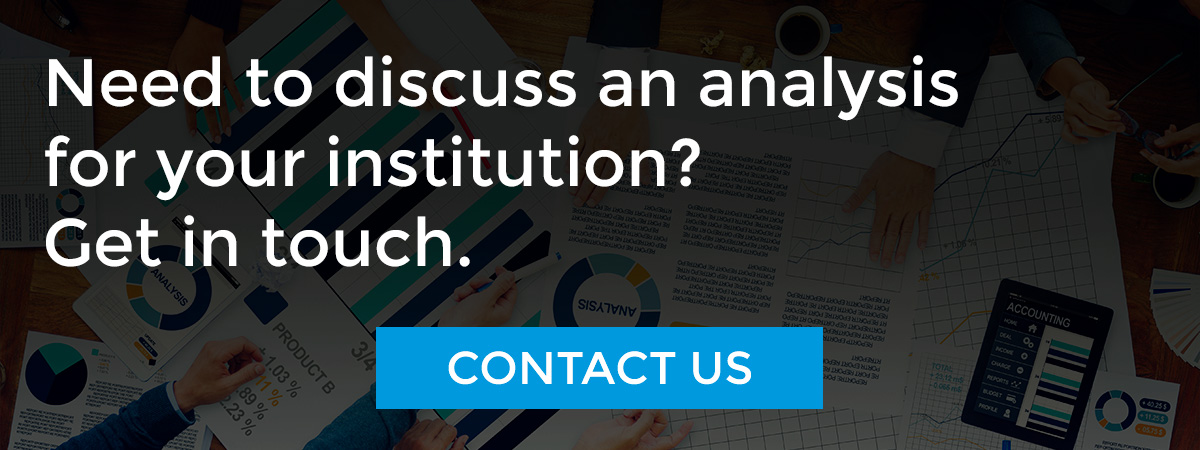While technological advances have increased efficiency and, in some ways, made things easier, these advances have also increased the speed at which things move and created more demands. One of these demands is the need to analyze ever-increasing quantities of data.
This data contains potential risks and potential rewards for financial institutions. It contains risks to the extent that these data are not appropriately and proactively analyzed, and rewards to the extent these data are used to identify and manage risk as well as opportunities.
The data tells a story and defines the trajectory of the institution. If the story is an unfavorable one, then changes must be made to change the trajectory. On the other hand, if the story is a favorable one, the data must be understood in order to determine what the key factors are that must remain in place to keep the current course for the institution.
Whether it is managing risk, evaluating past performance, or identifying marketing opportunities, actionable analysis relies on both utilizing proper techniques as well as accurate interpretation. Below, we lay out several key considerations and elements required to meet the challenge of data analysis in the modern age.
Analysis Must Be Intentional
As pointed out above, data contains both potential risks and potential rewards. Understanding this principle, and actively and intentionally taking advantage of these opportunities in one’s data, will unlock these potential benefits.
Failing to do so, on the other hand, not only means missing opportunities but can also create considerable risks.
In the regulatory context in particular, failing to recognize this can mean an institution can become the victim of its own data.
Knowing What Is – And is Not – Available
While understanding what potential exists within an institution’s data, it is equally important to understand what is in and not within the data.
In other words, is the institution’s data alone sufficient for analysis, or are there other sources of data that are needed to enhance internal data and provide context? These may be in the form of key benchmarks or simply enriching the institution’s data by supplementing from other sources.
With regard to analyzing credit, fair lending, and compliance risk, knowing what additional data are available and how these can be used are essential to comprehensive analyses.
Proper Techniques Must be Employed
The methods used to analyze data are becoming increasingly more sophisticated, utilizing more advanced statistical methods, including more complex modeling. The advances and availability of technological resources have accelerated this.
Many of the advances of the past few years have been almost entirely focused on more effectively managing and analyzing the vast amounts of data that are available. The technologist or analyst has at his or her disposal large libraries of advanced statistical routines with vast capabilities.
Combined with the speed and processing power afforded through cloud computing, the level of sophistication used to analyze data will only continue to increase. Institutions must understand this and have personnel both internally and externally that can keep up with this growing complexity and embrace the reality that using only simplistic analyses will likely become inadequate in the near term.
Interpretation and Communication
As we noted earlier, data is telling a story. Often, finding this story requires skilled interpretation which involves not only understanding key metrics and what they mean, but also the ability to “connect the dots” in order to see what the data is actually saying.
While the technologist may have the skills to apply proper techniques, correct interpretation requires additional expertise, including experience and abilities beyond strictly understanding statistical methods. Without this, a critical part of the puzzle will be missed.
Likewise, the findings of analyses need to be effectively communicated in a timely way. In this regard, interpretation is again critical in order to extract and prioritize what is meaningful.
Multi-Dimensional Perspective
The complexity of the data environment today demands a multifaceted approach. An institution must blend both internal and external resources.
While an institution must have expertise in-house for data management, it is unrealistic to expect that all the data analysis that is needed can be handled internally.
It is important to have partners that can help with the critical aspects of analysis, interpretation, and communication of the story the data is telling. In addition, having resources with intimate knowledge of an institution’s data and operations outside the organization helps to insulate against the risk of falling behind with critical analyses in the case of unexpected staff turnover. This has become essential in the current labor market.
There will also be times that unexpected internal demands can limit an institution’s capacity, and data analysis often becomes one of the first things that is neglected operationally. Having a reliable outside resource affords a number of benefits and is becoming more necessary with growing data demands.
A Forward-Looking Approach
Finally, for data to be of any real benefit, analyses must be timely and, ideally, viewed in terms of future impacts rather than historical results.
This requires, first and foremost, speed in completing the analyses and interpretation. The advent and quickly expanding use of machine learning and artificial intelligence is by far one of the biggest game changers in decades with respect to technology.
This expands capabilities for data analysis to those that embrace it and are willing to implement its use, and raises the bar for those that are slower in finding ways to capitalize on the tremendous enhancements it brings.
Not employing more advanced technologies in the future will make it very difficult to keep up with the mounting challenges that increased data availability presents.
Concluding Remarks
No financial institution should face the challenge modern data analysis presents alone, and the regulators themselves have confirmed this stance.
We at Premier Insights have decades of experience gathering, analyzing, and interpreting the exponentially increasing quantities of data available to financial institutions. Our methods are constantly evolving with the changing environment, and we are adding new capabilities and refined techniques on an ongoing basis to enhance the value we provide to our banks. We can help you craft policies and plans of action around what the data is telling you, implement operational programs to monitor for emerging risks and opportunities, and support you when your institution becomes subject to scrutiny as all institutions will.
Reach out to us today to discuss your institution’s analytical needs or any other challenges you are facing. We are available to assist you in any way that we can.



